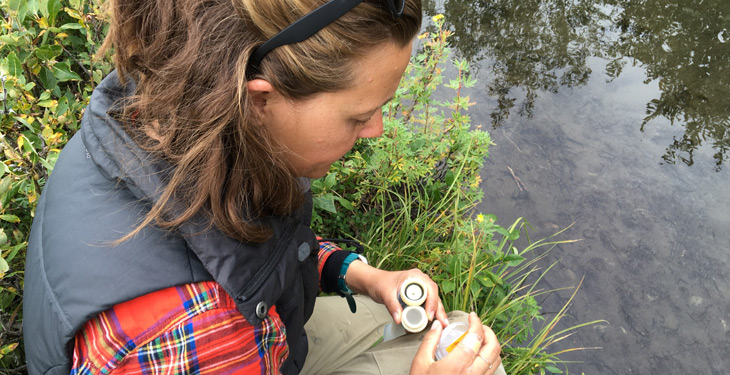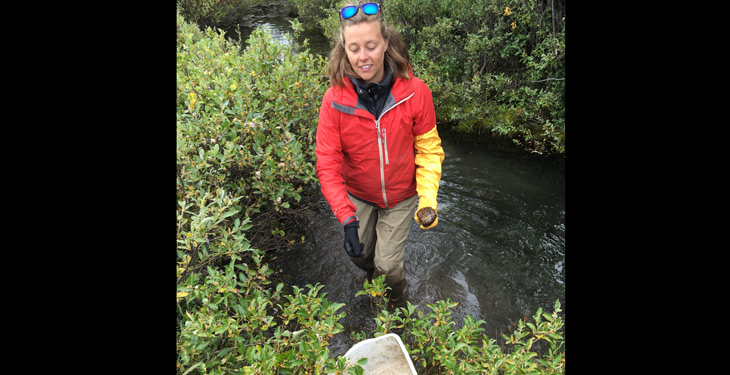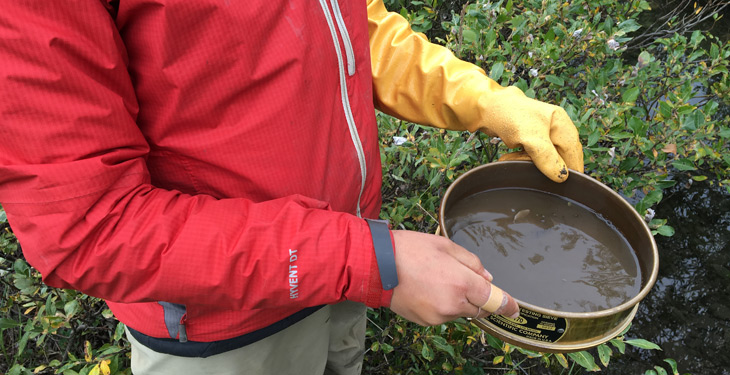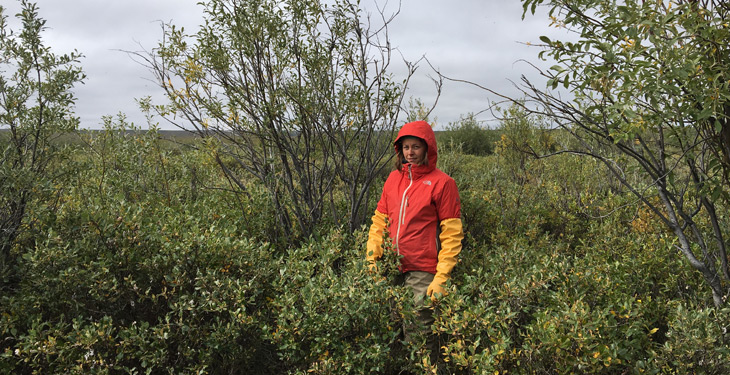A Day in the Life: Arctic ecologist
These scientists on Alaska’s North Slope do everything from fishing to scrubbing rocks

Mary Kate Swenarton pauses at a stream on the North Slope of Alaska. She’s trying to determine if fish called Arctic grayling are found here, and if so, why.
B. Brookshire/SSP
TOOLIK FIELD STATION, Alaska — Mary Kate Swenarton started college expecting to become an engineer. But she soon realized that she was missing something. It was the outdoors. “I realized I [would be] spending a lot of time in the office,” she says. She quickly switched to ecology — a field where she could study how organisms interact with their environments.
Now, she’s spending a summer here, at the Toolik Field Station. She’s what’s called a “research specialist” — someone who spends time carrying out experiments and collecting data under the direction of another scientist. Swenarton is working for Heidi Golden, a graduate student from the University of Connecticut in Storrs.

Swenarton came to Toolik after finishing her Masters’ degree at the University of North Florida in Jacksonville. There she had studied lionfish, an invasive species eating up local fish. She came to Alaska to collect data on a species of fish called Arctic grayling. She also studies the streams and rivers in which the fish live.
On a typical day, Swenarton hikes out to specially chosen streams in the tundra — the treeless, cold ecosystem where large portions of the deep soil remain frozen year-round. There, she will spend her day wading up to her waist in a stream with a tape measure to gauge the water’s length, width and depth. She will also catch tiny fish with a net and scrub rocks with a scrub brush. All of this is to find out more about grayling and their environment.
Alaska is divided into boroughs. These are equivalent to counties in the lower states. The North Slope is at the top of Alaska and spans about 246,000 square kilometers (95,000 square miles). In size, that one borough is roughly the same size as the state of Michigan. But it has only 9,500 people.
Toolik Field Station is especially remote. A tiny town built of shipping containers and weatherproof permanent tents, it exists to support the 60 to 100 scientists that work there every summer. It’s perched on a large gravel area right off the Dalton Highway — one of the only roads going through the North Slope Borough. It’s a several-hour drive to the nearest gas station, let alone the nearest town. While there’s no cell-phone reception, there is internet access. But this is a wild place. If you leave the immediate area, you’d better carry your bear spray — grizzly bears, caribou, moose and other wildlife are common. Many of the scientists at Toolik will spend their whole summer there, with no more than a weekend in a real town or city.
Spending so much time away from home can be hard. “This is not a typical summer,” Swenarton says. “In general, you might feel like you miss out a lot with your family and friends.” The hardest part for her, she says, is that her dog can’t come to Alaska, too. “I really struggle not being with her.”
This far north, the sun never sets between mid-May and August. The days may be long, but the summer itself is short. Scientists usually have only about three months before the cold — and the academic year — bring them back to the schools where they teach and work. So there’s no time to waste.
Swenarton heads out to study a stream by truck or helicopter immediately after breakfast. She may not return until it’s nearly time for dinner. Then, “about half the time,” she says, she’ll head to the lab at the field station after eating. She keeps to this schedule six days a week. But it’s worth it, she says. “This is the forefront,” she explains. “Everyone here is studying something that relates back to climate change. I’d never done that before.”
The experience is special, too. “You don’t get to go out to the Arctic tundra normally and live out in the middle of nowhere,” Swenarton explains. All the trails she has to hike are completely uncharted. “You’re making your own trails in the mountains.” Until now, she notes, “there’s nothing I’ve ever done that’s like that.”
During a day on Alaska’s North Slope, I followed Swenarton around as she examined a stream to find out what kind of habitat Arctic grayling like best. As the Arctic warms due to climate change, fish may change their habits. Understanding why they live where they do, she notes, “helps to predict how fish respond and what areas might be important to them in warming conditions.” Read on to see what a typical day for her is like.

Scientists have hiked two kilometers (1.2 miles) from the road to study a stream and the grayling in it. All the food, drink and the materials they will need to use have to be carried in with them. Those nets, sieves, tape measures and yardsticks, extra coats, bottles and tubes for samples will also have to be carried back out with them as well. No trash will be left behind. B. Brookshire/SSP 
Swenarton prepares a water sample. To find out what kinds of habitat grayling prefer, researchers need to learn how much oxygen and nutrients are in the water. B. Brookshire/SSP 
Swenarton gathers rocks from the stream bottom. One set of rocks was scrubbed vigorously with a wire brush to collect samples of chlorophyll — a pigment that helps green plants and algae make food out of sunlight and carbon dioxide. A lot of chlorophyll — the green pigment — could mean a lot of plants and algae in the environment. And that might mean food for the tiny organisms on which grayling feed. B. Brookshire/SSP 
Swenarton carefully filters the gunk she scrubbed off of some rocks in the streambed. This is to separate out and tally any tiny worms or insect larvae — good food sources for grayling. B. Brookshire/SSP 
Measuring a stream means measuring how wide it is, and how wide it could be. Here, Swenarton measured the total stream width, a measure of how wide the stream can expand during spring floods. B. Brookshire/SSP 
Here, Helen Chmura — another scientist working in the tundra — examines plants along the stream banks. These plants contribute to the stream habitat — and whether or not it’s suitable for fish. B. Brookshire/SSP 
Gone fishing! Swenarton uses a small net to try and catch ‘Young of the year.’ These are baby grayling that were born in the spring and early summer. Any fish she catches she brings back to the lab to weigh and measure. B. Brookshire/SSP 
Check out these grayling young of the year — or Y.O.Y. B. Brookshire/SSP